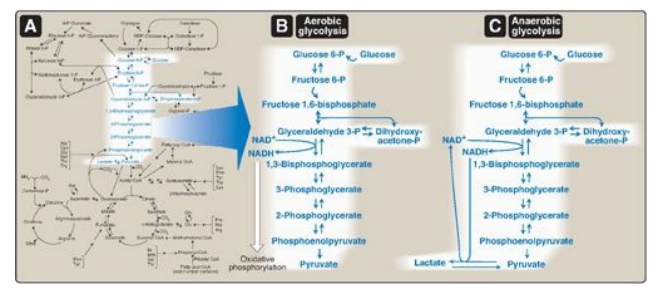Overview of Glycolysis
| Home | | Biochemistry |Chapter: Biochemistry : Introduction to Metabolism and Glycolysis
The glycolytic pathway is employed by all tissues for the oxidation of glucose to provide energy (in the form of ATP) and intermediates for other metabolic pathways.
OVERVIEW OF GLYCOLYSIS
The glycolytic pathway
is employed by all tissues for the oxidation of glucose to provide energy (in
the form of ATP) and intermediates for other metabolic pathways. Glycolysis is
at the hub of carbohydrate metabolism because virtually all sugars, whether
arising from the diet or from catabolic reactions in the body, can ultimately
be converted to glucose (Figure 8.9A). Pyruvate is the end product of
glycolysis in cells with mitochondria and an adequate supply of oxygen. This
series of ten reactions is called aerobic glycolysis because oxygen is required
to reoxidize the NADH formed during the oxidation of glyceraldehyde 3-phosphate
(Figure 8.9B). Aerobic glycolysis sets the stage for the oxidative
decarboxylation of pyruvate to acetyl CoA, a major fuel of the TCA cycle.
Alternatively, pyruvate is reduced to lactate as NADH is oxidized to NAD +
(Figure 8.9C). This conversion of glucose to lactate is called anaerobic
glycolysis because it can occur without the participation of oxygen. Anaerobic
glycolysis allows the production of ATP in tissues that lack mitochondria (for
example, red blood cells and parts of the eye) or in cells deprived of
sufficient oxygen.

Figure 8.9 A. Glycolysis
shown as one of the essential pathways of energy metabolism. B. Reactions of
aerobic glycolysis. C. Reactions of anaerobic glycolysis. NAD(H) = nicotinamide
adenine dinucleotide; P = phosphate.
Related Topics
